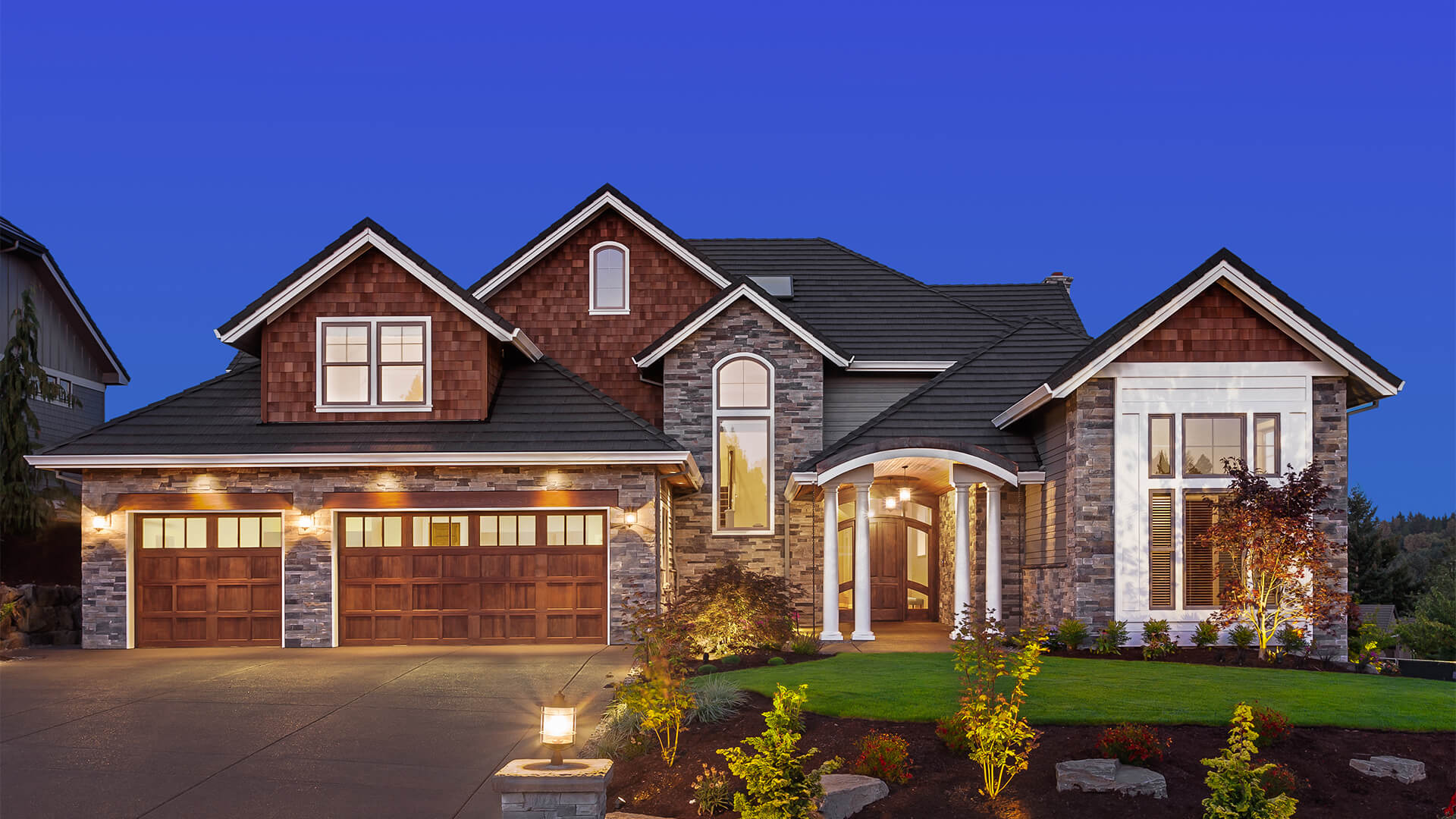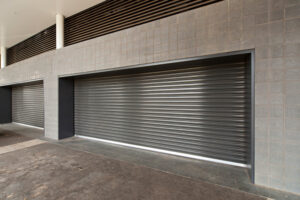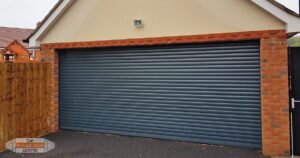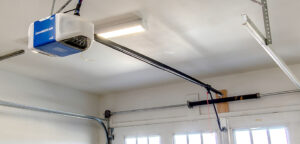What Are Garage Door Panels?

A garage door is not just a portal to your home’s storage and parking space, it is an integral part of the house’s architecture. A well-chosen garage door enhances curb appeal and adds to the overall aesthetic of your residence. While we often contemplate color, material, and design style, the anatomy of the garage door—particularly the panels—should not be overlooked. Understanding the different parts and their functions can help you make informed decisions about maintenance, repairs, and replacements.
At the heart of the garage door system are the panels. These are typically made from resilient materials such as steel, wood, or aluminum. Held securely in place by tracks on either side of the door, the panels are linked by hinges. It’s not merely a monolithic piece of construction; the panel, in fact, comprises various components, each serving its unique role in the bigger picture. This understanding provides an insight into the mechanics of a garage door and helps in choosing the perfect fit for your home.
Below are the key components of a garage door panel and their individual functions:
- Stiles: Stiles are the vertical framing on either side of the panel. Like the spine of a book, they lend structural integrity and hold the panel together.
- Top Rail: Acting as the uppermost horizontal beam of the panel, the top rail connects the stiles. This part carries a significant load, holding up against the forces exerted when the door is in motion.
- Bottom Rail: The counterpart to the top rail, the bottom rail is the horizontal piece at the bottom of the panel, connecting the stiles. It supports the panel’s weight and assists in maintaining balance and alignment.
- Center Stile: The vertical framing at the middle of the panel, the center stile serves as the divider separating the top and bottom sections. It aids in distributing weight evenly across the panel.
- Hinges: These essential pieces allow for the connection of panels to each other and the door track. The hinges enable the door to fold upon itself as it’s lifted, making upward motion possible.
- Locking Mechanism: This component safeguards your garage door against unwanted intrusions. It locks the door securely in place, providing peace of mind and enhancing home security.
Choosing the right garage door requires a good understanding of the standard sizes and how they fit into your specific garage layout. It’s worth noting that garage doors come in single, double, and triple variants to suit the needs of your property.
Single Garage Doors
The standard sizes for single garage doors typically range between 8’ x 7’, 8’ x 8’, 9’ x 7’, and 9’ x 8’. However, variations exist in the market to cater to differing garage sizes. Typically, these doors measure 7 – 8 ft in height and 8 – 10 ft in width.
In recent years, there has been a trend towards larger single garage doors, particularly those that reach 9 – 12 ft in height. While these are less common, they are available from certain providers, and you can also order these sizes as custom garage doors if your garage requires a door of this scale.
Double Garage Doors
When it comes to double garage doors, the most frequently encountered size is 16’ x 7’. Nevertheless, just like single garage doors, the dimensions can vary. Double garage doors can measure between 7 – 8 ft in height and 12 – 20 ft in width. If your garage space doesn’t fit these standard dimensions, don’t worry, custom orders are an option here as well.
Triple Garage Doors
The largest of the three, these can accommodate three vehicles side-by-side, with standard sizes around 20 x 7 feet, 18 x 7 feet, and 16 x 7 feet. The door setup might comprise multiple garage doors, often accompanied by posts between them for added structural stability. Typical configurations include three single garage doors or one single garage door paired with a double garage door.
| Width | Height | |
|---|---|---|
| Single Garage Door | 8 to 10 feet | 7 to 8 feet |
| Double Garage Door | 12 to 16 feet | 7 to 8 feet |
| Triple Garage Door | 22 to 26 feet | 7 to 8 feet |
Currently, there are no standard sizes for single, large garage doors meant for three-car garages on the residential front. But that doesn’t mean you’re out of options. Custom doors can be created to suit your specific needs, providing you with the perfect solution for your triple garage.
Another crucial aspect to ponder upon when selecting your garage door panels is the directional option. The three main choices include vertical, horizontal, or herringbone. Vertical panels, the most common, run up and down the door, while horizontal panels go across. Herringbone panels have a distinctive V-pattern, resembling the skeleton of a herring, and offer a unique design appeal.
Understanding the various parts of a garage door, from panels to rails and hinges, can seem like a daunting task. Hence, we’ve put together an infographic to help visually break down these elements for you.
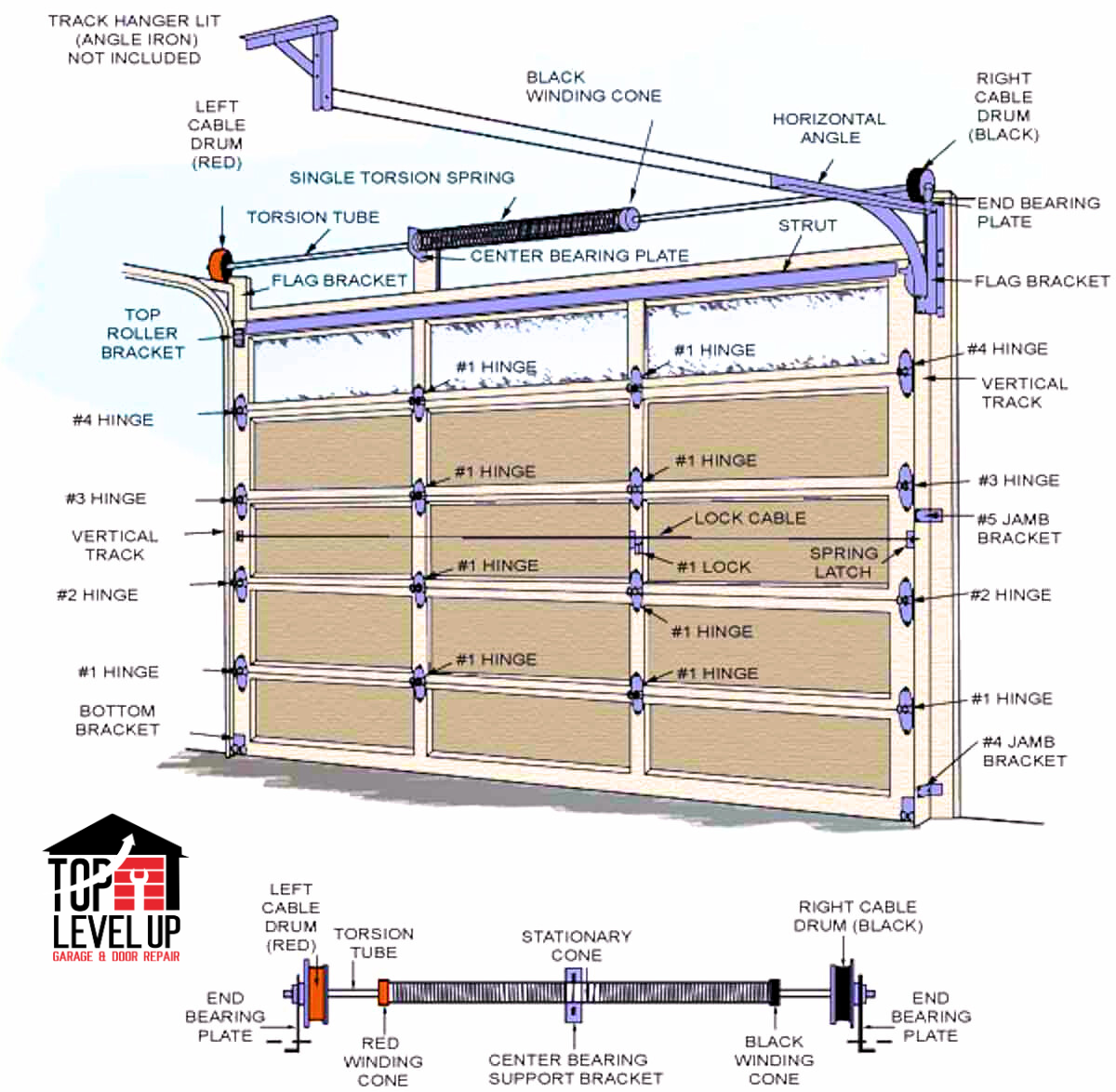
Trying get the right garage door size is essential for both the aesthetics and functionality of your home. The broad range of standard sizes and the availability of custom options mean that there’s a garage door out there to suit every garage, no matter its size or design.
What Are My Garage Door Panel Style Options?

Choosing the perfect garage door panels to suit your home involves a wide array of options. While the possibilities may seem infinite, this blog will delve into the impressive assortment of garage door panel options from TOP Level Up to guide you through the selection process. Do note that these options are product line dependent and may not be available for every garage door. Let’s explore our current range of panel selections:
- Steel Garage Doors
Boasting of resilience and top-notch quality, steel garage doors are an economical choice. Their affordability does not compromise their durability, making them a popular option among homeowners. These doors come in various design options, all of which are cost-effective.
The light weight of steel, despite its sturdy nature, is an added advantage. High-grade steel can withstand heavy usage and stress. However, steel is prone to rusting without a special coating, especially in areas with heavy snowfall where the road salts can accelerate rust formation. Regular washing at least twice a year can help prevent rust and prolong the lifespan of your steel door.
Pros:
- Durable and damage-resistant
- Economical with low maintenance requirements
Cons:
- Provides less insulation
- Prone to rust and corrosion
- Low-quality steel can be easily damaged
- Aluminium Garage Doors
Known for their modern aesthetic, aluminum doors offer a range of design options. Being malleable, they are easy to customize with numerous options for window placement, coatings, and colors. However, these lightweight doors are susceptible to damage from strong winds or flying objects. Significant damage might make door replacement a more viable option than repair.
You can increase the R-value by adding insulation to the aluminum rails, boosting the door’s thermal protection.
Pros:
- Corrosion-resistant and low-maintenance
Cons:
- Less durable and prone to denting
- Sensitive to extreme heat
- Wood Composite Garage Doors
Made from recycled materials like plastic fiber and reclaimed wood, composite garage doors simulate the look of genuine wood doors. They can be insulated to improve temperature control.
Pros:
- Aesthetically similar to wood
- Affordable and durable
- Rot-resistant
Cons:
- Prone to chipping and cracking
- Requires maintenance
- Fiberglass Garage Doors
Fiberglass doors mimic the look and feel of real wood and resist shrinking and warping. However, they may crack over time and are susceptible to wind damage.
Pros:
- Low-maintenance
- Resistant to warping and corrosion
Cons:
- May crack with age
- Vulnerable to wind damage
- Vinyl Garage Doors
Vinyl doors are strong, durable, and require minimal maintenance. But, their color can’t be changed after production.
Pros:
- Durable and damage-resistant
- Corrosion and rust-resistant
Cons:
- Original color can’t be changed
- Less insulated without additional materials
Pros and Cons of Different Materials and Styles of Garage Doors
| Garage Door Panel Material | Pros | Cons |
|---|---|---|
| Wood | Authentic look, Customizable, Insulates well | Requires maintenance, Can be expensive |
| Vinyl | Low maintenance, Resistant to dents | Limited in color and design options |
| Aluminum | Lightweight, Resistant to rust | Can be easily dented |
| Fiberglass | Modern look, Allows natural light | Can compromise privacy, Fragile |
| Composite Wood | Low maintenance, Resistant to rot and splitting | Can be more expensive than real wood |
Each of these materials presents unique benefits and drawbacks, enabling homeowners to choose based on their specific needs, aesthetic preferences, and budget. For instance, wood offers an authentic, rustic look that many homeowners adore, but requires consistent maintenance to keep it looking its best. On the other hand, vinyl is a low-maintenance and dent-resistant option, but offers fewer customisation options.
How Often Should Garage Door Panels Be Serviced?

A regularly maintained garage door panel isn’t just an aesthetic enhancement but an essential component in ensuring the longevity and dependability of your garage door system. At TOP Level Up, we believe that a well-maintained garage door panel can indeed save you from costly future repairs and replacements. Below, we’ve compiled an extensive guide and some useful tips on keeping your garage door panels in top-notch condition:
Regular Lubrication: Your garage door’s tracks, rollers, and springs are constantly subjected to friction due to their incessant movement. Regularly lubricating these elements can significantly reduce friction and ensure smoother movement. Lubrication can also help to prevent premature wear and tear of these crucial components.
Consistent Balance Check: Another vital tip in garage door maintenance is to constantly check the balance of the door. This can be achieved by disconnecting the opener and manually lifting the door. This ensures that the door is neither excessively heavy nor too light, thereby promoting even distribution of weight and reducing undue strain on the components.
Regular Inspection: Frequent inspection of the panels, tracks, and hinges is necessary to detect any potential damage or signs of wear and tear early. Be on the lookout for cracks, dents, rust, or any other form of deformities that could hamper the door’s functionality.
Tighten and Replace: Over time, screws and bolts on your garage door may become loose. Regularly tightening these parts can go a long way in maintaining the door’s structural integrity. Similarly, any damaged or worn-out components should be promptly replaced to avoid more significant issues down the line.
Cleanliness is Crucial: It’s recommended to clean the garage door panels periodically using mild soap and water. Avoid using harsh chemicals or abrasive cleaners as they could potentially damage the panels’ finish and lead to discoloration.
We’ve created a table below that outlines the various types of garage door panels, explaining when they should be maintained or replaced:
| Garage Door Panel Type | Average Lifespan | Maintenance | Replacement Signs |
|---|---|---|---|
| Raised Panel | 20 – 25 years | Lubricate every six months; Clean quarterly | Cracks, warping |
| Flush Panel | 15 – 20 years | Lubricate every four months; Clean quarterly | Severe dents, broken sections |
| Carriage House Panel | 25 – 30 years | Lubricate bi-annually; Clean bi-annually | Faded color, warping |
| Glass Panel | 15 – 20 years | Clean monthly | Cracks, shattering |
What to Keep in Mind When Replacing Your Garage Door Panels?
Taking on the task of garage door panel substitution isn’t as simple as picking up a screwdriver and hammer. Several factors come into play, from the material selection to gauging the extent of the damage. Every garage door material brings with it a different durability level, insulation efficiency, and aesthetic value. Therefore, the selection of an appropriate replacement panel should not be taken lightly. It is a decision that warrants a serious consideration of your unique requirements and taste.
Garage door panel repair is a two-fold process. Some repairs can be undertaken as a DIY project, while others necessitate the touch of a seasoned professional. Pondering over a panel replacement for your garage door? Here are a few considerations to take into account before choosing between the DIY route or summoning a professional from Top Level Up.
The first thing to deliberate on is the degree of damage sustained by your garage door panels. Small dents or superficial scratches may not require professional attention. A bit of manual work involving a hammer, pliers, or even some sandpaper could do the trick. On the contrary, should your panels bear deep-set dents or significant cracks, the safer and more effective option would be to let the professionals handle the replacement.
The second vital factor to mull over is your comfort and proficiency level when it comes to DIY tasks. Replacing garage door panels may appear simple on the surface but it’s an intricate and labor-intensive process. The lack of proper tools and inadequate knowledge about the process could further complicate matters. If you’re not completely confident in your ability to replace your garage door panels, it’s a wise choice to delegate the task to a professional.
Here is a quick overview of the garage door panel replacement process done by a professional::
Inspection: The professional first examines the panel to determine the extent of the damage and identify the right panel type for replacement.
Removing the Old Panel: The damaged panel is carefully removed to prevent any further damage to the door or the panel.
Preparing the New Panel: The replacement panel is prepared and customized to fit into the existing door system.
Installing the New Panel: The new panel is installed carefully, ensuring it aligns correctly with the other panels.
Finishing Touches: Final adjustments are made, and the door is tested for smooth operation.
The entire process typically takes a couple of hours, but it could vary depending on the garage door type and the damage extent.
Tilt-up/Up-and-Over Door Panels: These panels lift up and out, sliding into a horizontal position along the garage ceiling when open. Replacement typically takes 3-4 hours per panel.
Sectional Door Panels: Composed of 3-8 large panels that slide up overhead into the garage when opened, these are the most common type of door. Replacement usually takes about 2-3 hours per panel due to their modular nature.
Roll-up Door Panels: Consisting of many small sections joined together, these doors open by rolling upward into a cylinder above the opening. Panel replacement can take a little longer, generally about 4-5 hours per panel due to their intricate design.
In conclusion, garage door panels are a key and often underestimated component of the functionality and appearance of your garage doors. Regular maintenance of your panels and addressing any problems swiftly can ascertain your garage door’s prolonged lifespan and safety. Whether you are in need of a panel replacement, repair, or regular maintenance, Top Level Up is at your service. We are your ultimate solution for all garage door needs in Surrey, BC. We take immense pride in offering superior service and expertise. Reach out to us today to schedule a consultation or learn more about our wide range of services.
.

